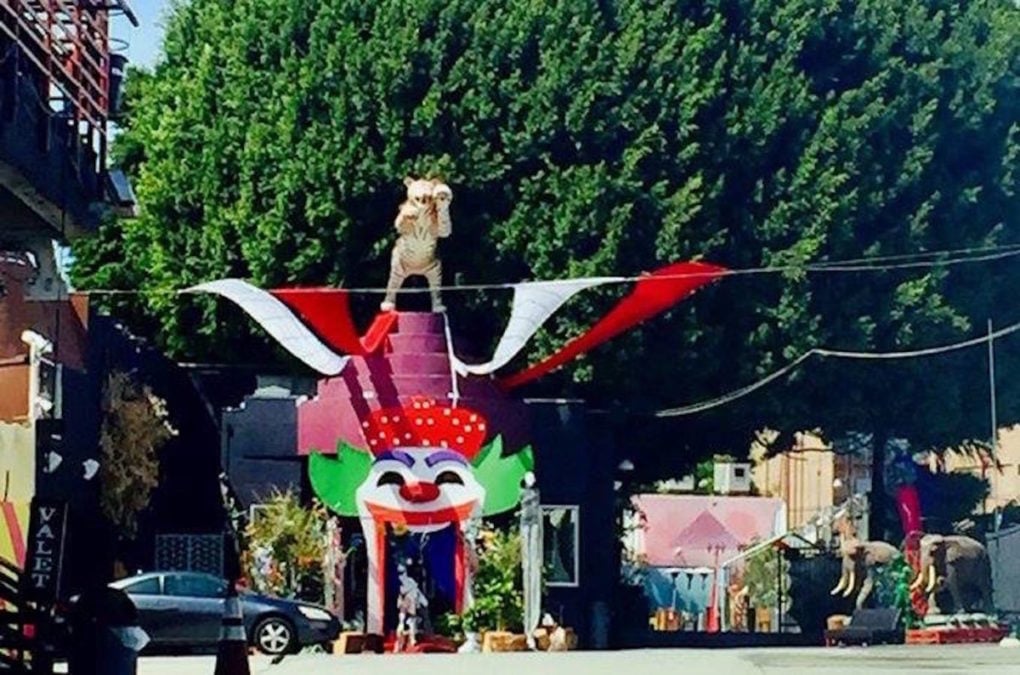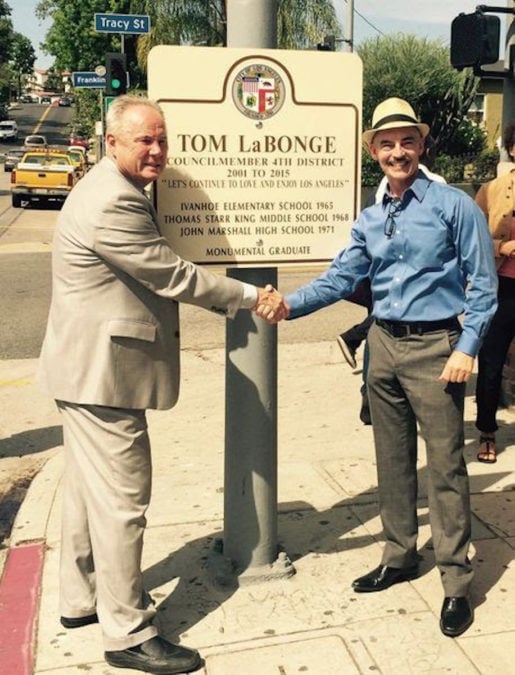
Circus Disco was the oldest, and longest-running LGBTQ Latino nightclub in Hollywood and Los Angeles. For 40 years, it was not only a place to socialize and have fun, but also a sanctuary for the Latino LGBTQ community to develop a sense of identity, community and social support. Photo: LA Conservancy.
In covering the death of former L.A. City Councilman Tom LaBonge, numerous outlets said he adored the City of Angels.
LaBonge, they said, was well known for his love of the city’s history, its landmarks, its public spaces and its people — and he loved to celebrate all those things.
From 2001 to 2015, LaBonge represented Los Angeles’ 4th District, a vast area that stretches into Koreatown and Mid-Wilshire on the south; through the Miracle Mile, Fairfax District, the Hollywood Hills into Sherman Oaks on the west; through much of Hollywood and over Cahuenga Pass into North Hollywood on the north; and through Los Feliz and Griffith Park into much of Silver Lake on the east.
The district includes many of Los Angeles’ tourist destinations, such as the Hollywood Boulevard district, the La Brea Tar Pits and Los Angeles County Museum of Art, Farmers Market and The Grove, Griffith Park with the Hollywood Sign and Griffith Observatory, the Hollywood Bowl, and Universal Studios.
LaBonge, 67, died at his Silver Lake home on January 7. His wife, Brigid Manning, said he was laying on the couch, and she couldn’t wake him up. A cause of death has not been released yet.
Tom LaBonge
Known as “Mr. Los Angeles,” LaBonge was “a walking encyclopedia of all the amazing things and spots and neighborhoods and institutions in L.A.,” Councilman Mike Bonin told the Los Angeles Times. “He was the Huell Howser of L.A. politics, a spirit that was always optimistic and in love with the city.”
But one part of LaBonge’s legacy was absent from all the coverage — LaBonge was instrumental in demolishing Circus Disco and Arena Cafe — two historic dance clubs that were safe spaces for LGBTQ Latinos.
Circus Disco was the oldest and longest continuously operating nightclub for LGBTQ Latinos in Hollywood and Los Angeles.
The clubs were located in Hollywood on Santa Monica Boulevard and Las Palmas Avenue, just east of Highland Avenue, and were a vital part of Los Angeles and LGBTQ Latino history.

Tom LaBonge, left, and Los Angeles City Councilman Mitch O’Farrell are photographed in 2015. Photo: Office of City Councilman Mitch O’Farrell.
The clubs were located across the street from the famed Hollywood Center Studios, where such iconic TV shows as “I Love Lucy,” “The Addams Family” and “The Cosby Show” as well as such movies as “Bad Santa,” “Misery” and “Ted” were filmed.
Circus Disco and Arena Cafe closed their doors Jan. 1 , 2016. The bulldozers arrived the following month and reduced the historic spaces to rubble to make way for a gigantic mixed-use development with 695 expensive apartments.
LGBTQ Latino history ignored
At the request of Gene La Pietra, who owned Circus Disco and Arena Cafe, LaBonge played a pivotal role in getting the zoning for the property changed in 2015 from industrial and commercial to residential. Those entitlements allowed La Pietra to move ahead with The Lexington Project, the mammoth apartment development plan that La Pietra envisioned for the 6-acre site.
LaBonge acknowledged in a 2015 interview with Out in the 562 that the Lexington Project site included “lots and lots of history.” But when asked why he didn’t acknowledge Circus Disco as a historic and cultural space in any reports on The Lexington Project, he said, “I don’t know.”
LaBonge said he would call back with an explanation, but didn’t. Several follow-up calls were made to LaBonge, but he never responded, according to the article.
La Pietra sold the property in mid 2015 for $75 million to AvalonBay Communities. In early 2016, they demolished the historic venues and replaced them with their own sprawling development called Avalon Hollywood at La Pietra Place.
Oil Can Harry’s — historic 52-year-old gay club — has closed
Circus Disco history
Circus Disco was founded in 1974 by La Pietra and Ermilio Lemos, his boyfriend at the time. They opened the nightclub after Lemos and some gay Latino friends were discriminated against at a West Hollywood nightclub with a predominately white clientele.
The building originally served as a warehouse as part of an industrial site.
LGBTQ life in Los Angeles in the 1970s was largely underground and functioned along the lines of a subculture. This was primarily due to social and cultural intolerance as well as laws that either directly or indirectly discriminated against LGBTQ people.
As a result of persecution and harassment, especially from law enforcement, most in the LGBTQ community could only socialize publicly in businesses that were openly supportive. In turn, these businesses also became centers for political activism and the fight for civil rights.
Going to the circus
Patrons to Circus Disco entered the club through the laughing mouth of a huge clown’s face that was flanked on both sides by large plaster elephants. High above on a pedestal, a fiberglas lion seemed to be scanning the procession of big-top patrons.
If the exterior of Circus Disco turned heads, the inside of the club had them spinning. Circus Disco was colossal — 26,937 square feet on two floors with three rooms pumping out dance beats and pulsating laser lights.
For more than 40 years, Circus Disco was not only a place to socialize and dance, but also a sanctuary for the Latino LGBTQ community to develop a sense of identity, community, and social support.
Controversial Lexington Project
La Pietra’s Lexington Project was controversial.
LGBTQ Latino advocates and historic preservationists were upset about it. They were not aware of the project, were never given a chance to participate in any public hearings or comment about the project, and LaBonge never reached out to them for feedback on the project, they told Out in the 562.
Even though La Pietra made millions of dollars off the LGBTQ Latino community with his night clubs, community activists said he never sought their input on the project.
Also, they said The Lexington Project was flawed. Specifically, they pointed to The Lexington Project’s environmental impact report – a document required by state law. It’s a comprehensive analysis and public disclosure of all potential environmental impacts for development projects that must include all feasible solutions to mitigate those impacts.
Historic resources ignored
The report also must take into consideration historic and cultural resources, such as buildings, at a proposed site and the impact if those structures are demolished.
If historic or cultural resources are confirmed at a site, or if resources are approved as a historic landmark, they could present huge hurdles to the project, such as delaying construction or preventing the building from being torn down or altered.
But the Lexington Project’s environmental impact report avoided those potential obstacles.
“The project site does not contain any historic resources,” the report said.
LGBTQ Latino advocates and historic preservationists said that the report ignored and neglected to mention that the LGBTQ Latino community had considered Circus Disco a cultural landmark and safe space more than 40 years.
Also, in 2014, Circus Disco was listed in Survey LA’s LGBT Historic Context Statement, which was prepared by the city’s Office of Historic Resources.
Even city officials in the Historic Resources department seemed blindsided by The Lexington Project.
“It’s very surprising,” Ken Bernstein, the city’s historic resources manager, told Out in the 562. “If someone with the planning department or the developer had raised the issue that a site might have historic merit, our office would have been brought in.”
LaBonge approves Circus Disco demolition
But in February 2015, LaBonge and his fellow council members approved the EIR and changed the zoning that allowed residential use of the Circus Disco site.
However, LGBTQ Latino advocates and historic preservationists wanted the city council to re-open the EIR and have it amended to include historical and cultural information about Circus Disco. They also wanted to have a discussion about what should be done with the property, according to Out in the 562.
LaBonge never allowed those conversations to happen, and he didn’t make any effort to change the EIR.
In a last effort to preserve Circus Disco, Hollywood Heritage stepped up in December 2015 and tried to have Circus Disco designated as a historic-cultural monument, which most likely would have disrupted AvalonBay’s construction plans.
Preserving the memory
But three hours before the city’s Cultural Heritage Commission was scheduled to have a hearing about designating Circus Disco a historic landmark, AvalonBay officials, who publicly had dismissed any notion that Circus Disco was a historic and cultural resource, said they wanted to talk with Hollywood Heritage.
Eventually, it was discovered that part of the original club had been torn down decades ago, which would have made it challenging to save the building as a historic monument.
The focus shifted to preserving Circus Disco’s memory. AvalonBay said it would incorporate historic elements from the club into the complex. Those items would include neon ceiling lights, a disco ball, and part of the dancefloor.
In return, Hollywood Heritage withdrew its historic monument application.
The Avalon Hollywood complex opened in October.
The neon disco lights are located in the parking structure ceiling on the ground level.
The disco ball and part of the original dance floor are part of the lounge in building three.
That’s it.
In both instances, no photos or descriptions accompany the elements to provide context for visitors. No information about Circus Disco’s historic importance to the LGBTQ Latino community or Los Angeles.
It’s a measly representation for such a vital safe space and amazing Los Angeles institution.
